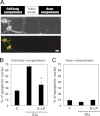A potential neuroprotective role of apolipoprotein E-containing lipoproteins through low density lipoprotein receptor-related protein 1 in normal tension glaucoma
- PMID: 22674573
- PMCID: PMC3408193
- DOI: 10.1074/jbc.M112.370130
A potential neuroprotective role of apolipoprotein E-containing lipoproteins through low density lipoprotein receptor-related protein 1 in normal tension glaucoma
Abstract
Glaucoma is an optic neuropathy and the second major cause of blindness worldwide next to cataracts. The protection from retinal ganglion cell (RGC) loss, one of the main characteristics of glaucoma, would be a straightforward treatment for this disorder. However, the clinical application of neuroprotection has not, so far, been successful. Here, we report that apolipoprotein E-containing lipoproteins (E-LPs) protect primary cultured RGCs from Ca(2+)-dependent, and mitochondrion-mediated, apoptosis induced by glutamate. Binding of E-LPs to the low density lipoprotein receptor-related protein 1 recruited the N-methyl-d-aspartate receptor, blocked intracellular Ca(2+) elevation, and inactivated glycogen synthase kinase 3β, thereby inhibiting apoptosis. When compared with contralateral eyes treated with phosphate-buffered saline, intravitreal administration of E-LPs protected against RGC loss in glutamate aspartate transporter-deficient mice, a model of normal tension glaucoma that causes glaucomatous optic neuropathy without elevation of intraocular pressure. Although the presence of α2-macroglobulin, another ligand of the low density lipoprotein receptor-related protein 1, interfered with the neuroprotective effect of E-LPs against glutamate-induced neurotoxicity, the addition of E-LPs overcame the inhibitory effect of α2-macroglobulin. These findings may provide a potential therapeutic strategy for normal tension glaucoma by an LRP1-mediated pathway.
Figures









References
-
- Quigley H. A. (2011) Glaucoma. Lancet 377, 1367–1377 - PubMed
-
- Iwase A., Suzuki Y., Araie M., Yamamoto T., Abe H., Shirato S., Kuwayama Y., Mishima H. K., Shimizu H., Tomita G., Inoue Y., Kitazawa Y. (2004) The prevalence of primary open-angle glaucoma in Japanese: the Tajimi Study. Ophthalmology 111, 1641–1648 - PubMed
-
- Pekmezci M., Vo B., Lim A. K., Hirabayashi D. R., Tanaka G. H., Weinreb R. N., Lin S. C. (2009) The characteristics of glaucoma in Japanese Americans. Arch. Ophthalmol. 127, 167–171 - PubMed
Publication types
MeSH terms
Substances
LinkOut - more resources
Full Text Sources
Other Literature Sources
Molecular Biology Databases
Research Materials
Miscellaneous

